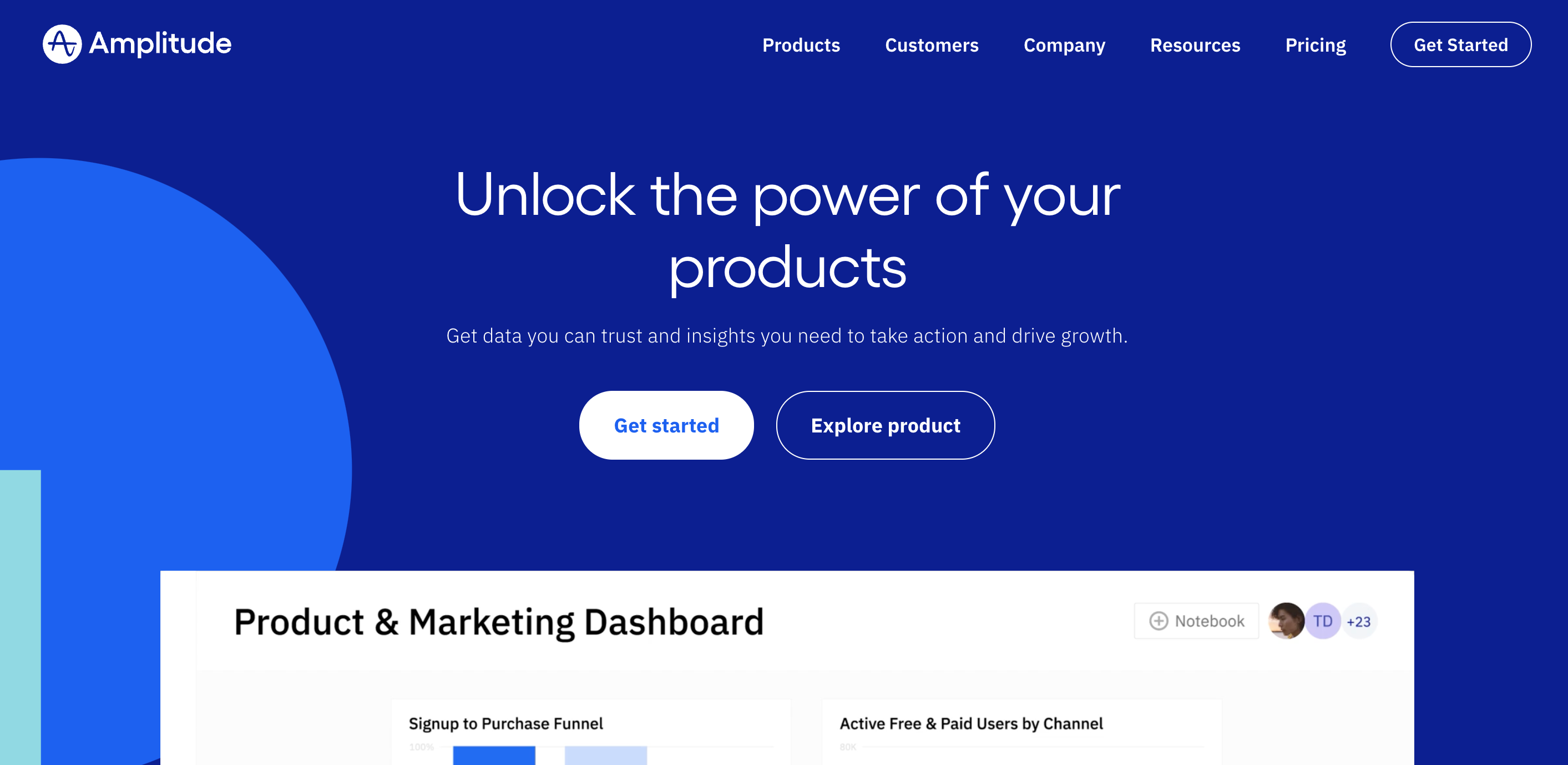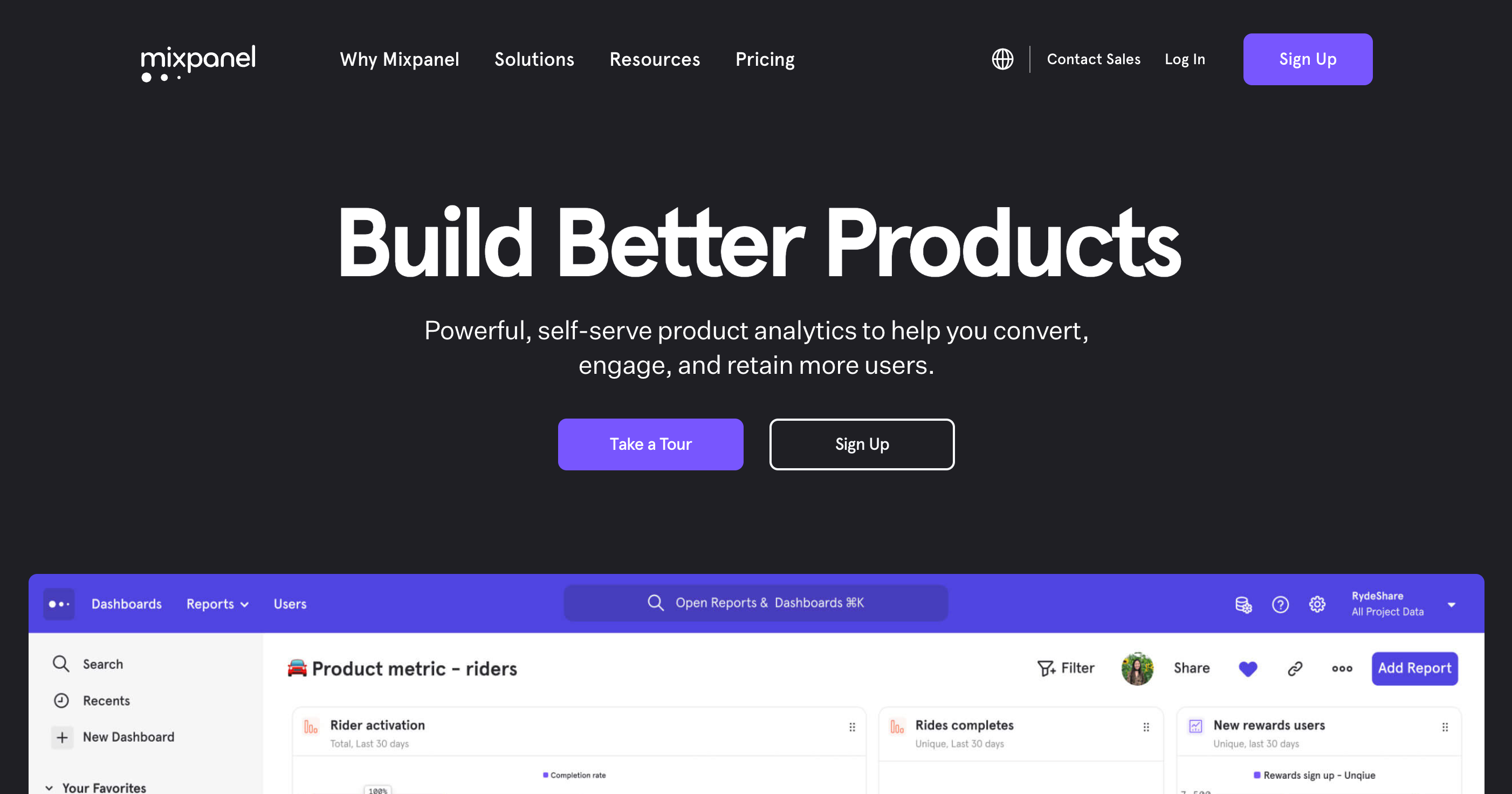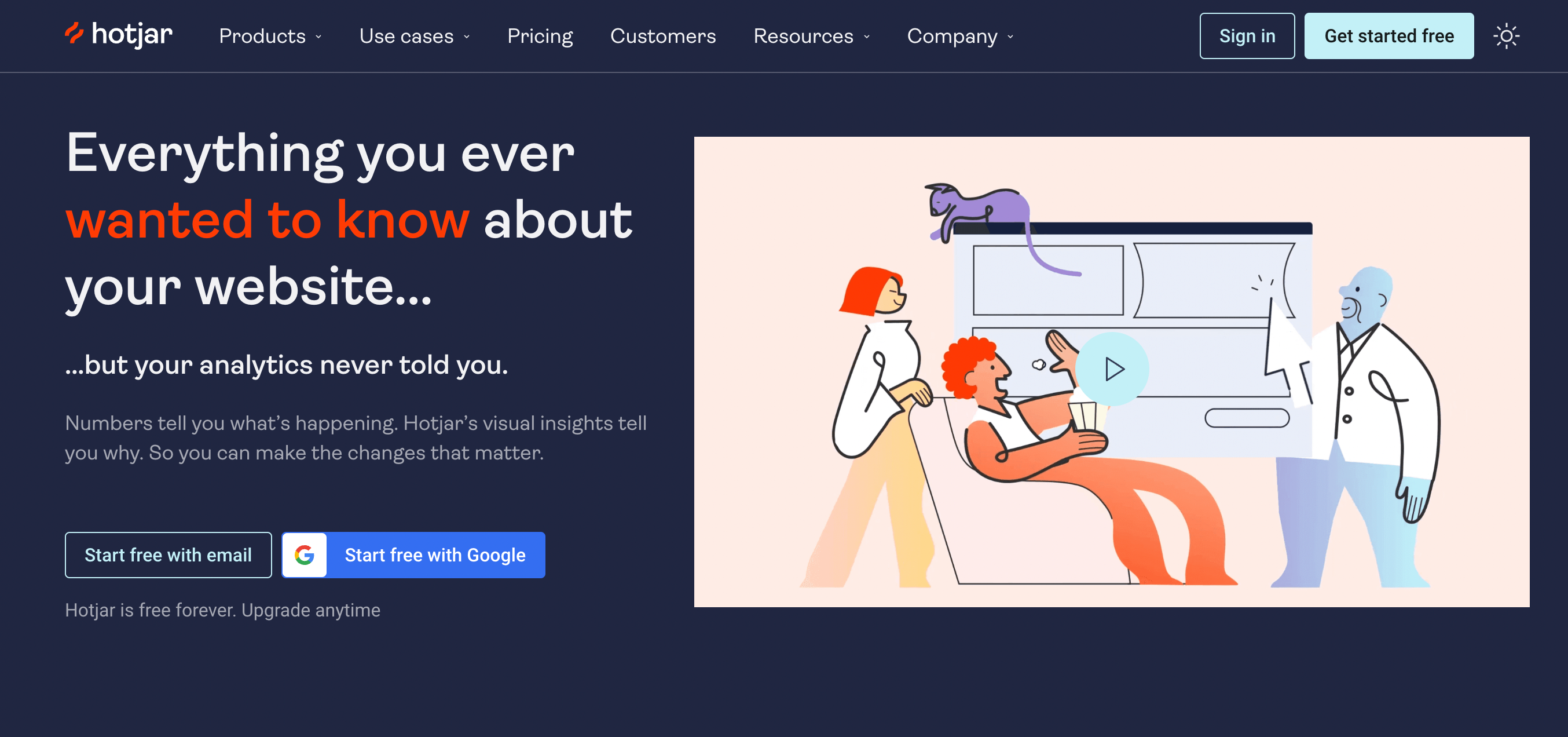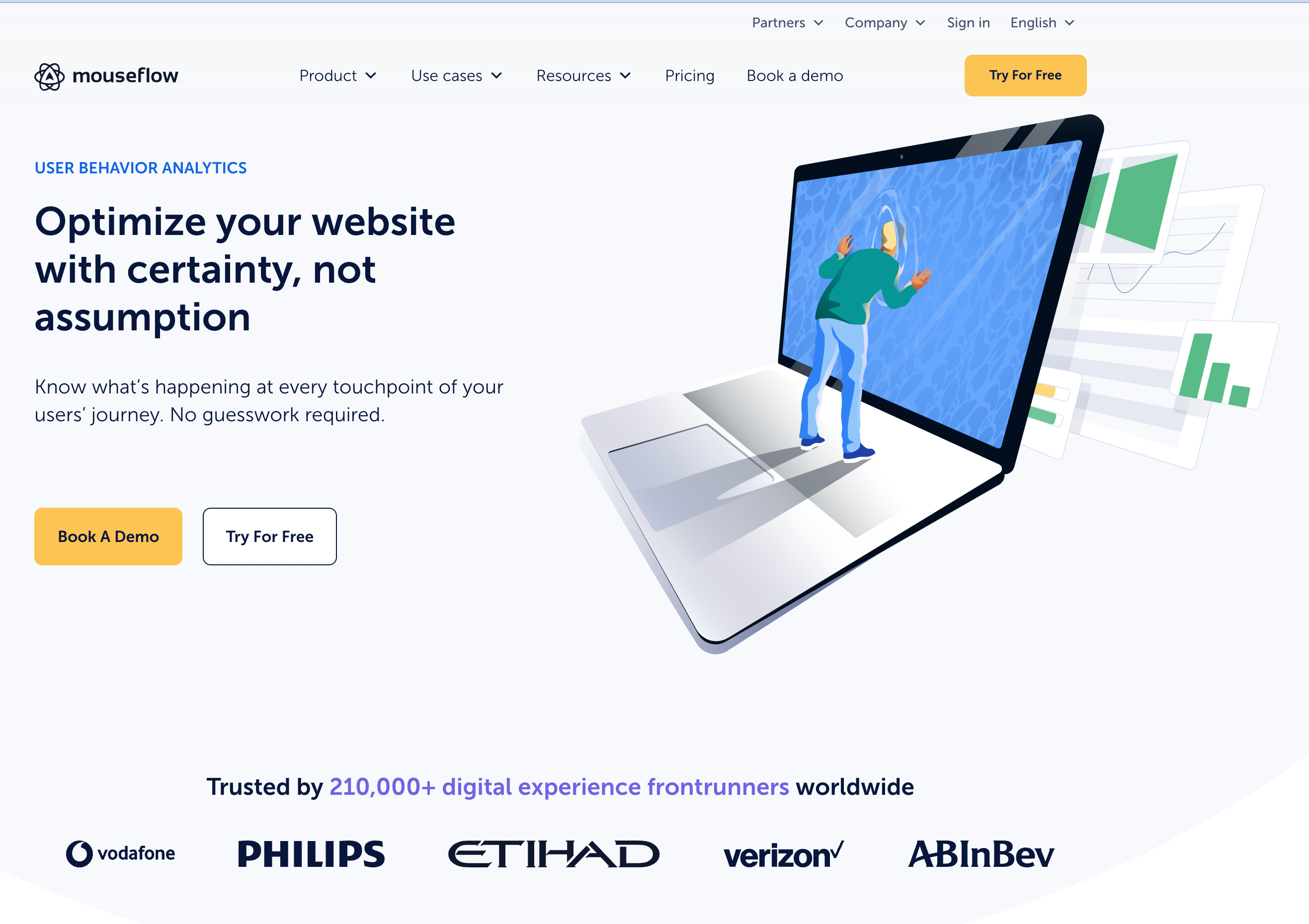8 Best UX analytics tools and software 2025
PUBLISHED
7 December, 2024

Growth Lead

User experience (UX) analytics help designers understand users’ behavior and how they interact with digital products. Designers use this information to make better design decisions that will improve the user experience of a product.
Below, we look at the UX analytics tools for mobile apps and web platforms you can use to gain insights about user behavior. The tools we discuss can help UX designers and researchers collect, analyze, and report on user data. We’ll dig into tools for different platforms spanning a wide price range.
What are the best UX Analytics tools?
In case you’re in a rush, here's a list of the top UX analytics tools we’ll cover:
UXCam
Amplitude
Adobe Analytics
Mixpanel
Hotjar
Maze
Mouseflow
Lookback
Now, let’s dive in.
Summary - Best UX analytics tools
| Tool | Best For |
|---|---|
| UXCam | Comprehensive product analytics for mobile app and web apps, including session replays and heatmaps. |
| Amplitude | Advanced behavioral analytics for web and mobile platforms. |
| Adobe Analytics | Multi-channel quantitative analytics with predictive capabilities. |
| Mixpanel | Retention and engagement analysis with A/B testing features. |
| Hotjar | Session recordings and heatmaps for web platforms. |
| Maze | Rapid testing and validation of design prototypes. |
| Mouseflow | Session replay and heatmaps with form analytics for websites. |
| Lookback | Remote user research and live interviews for usability testing. |
UXCam

Pricing: Upon request
Free trial: Free-forever plan + 14-day free trial for paid plans
Support for: Mobile apps
UXCam is a must-have solution to study mobile app user behavior, giving you contextual and high-fidelity insights that you won’t get elsewhere.
You can use it to understand how they behave and what they think when they use your product. All you have to do is get the software development kit (SDK) integrated into your application, and UXCam will start collecting data.
The SDK allows you to record user sessions and track users’ behaviors so that you can gain deeper insight into their experience on your platform.
How to analyze UX with UXCam
UXCam can enable product managers to deliver better user experience (UX) for their mobile app by providing them with valuable insights into how users are interacting with the app.
The platform allows for the tracking of user sessions, clicks, and gestures, and provides detailed reports on key metrics such as session duration, user flow, and heatmaps. This information can be used to identify patterns and trends in user behavior, such as which features are most popular, where users are dropping off, and what actions are leading to conversions.
With UXCam, product managers can also use the session replay feature to see the exact journey of the user, clicks and interactions with the app which can help identify usability issues and fix them. This can be especially helpful for identifying and resolving issues related to navigation, interface design, and overall usability. Additionally, UXCam allows for the creation of custom events, which can be used to track specific actions within the app, such as purchases or in-app sign-ups, and can provide insights into how users are engaging with the app's most important features.
By using UXCam, product managers can gain a deeper understanding of how users interact with their mobile app and use this information to make data-driven decisions about how to improve the user experience. This can lead to increased user engagement, retention, and ultimately better conversions for the app.
Features
Session replay: With UXCam, you can replay session recordings and analyze them using user frustration signals. The tool lets you apply advanced filters to recordings or segment them by mobile events, such as UI freezes, rage taps, and crashes.
Event analytics: UXCam provides detailed event analytics. With this feature, you can measure the performance of your product and use event-based funnels to get qualitative insights.
Heat maps: UXCam’s heat maps show you user behavior on every screen. You can use the info from the heat maps to fix design bottlenecks on your platform.
Issue analytics: This tool lets you export technical logs and resolve UI freezes. You can also identify bugs and crashes on your mobile app.
Screen flow analytics: UXCam gives a complete overview of user screen flow. You can use this feature to build app flows that guide users on their journey.
If you have questions about UXCam, request a 1:1 demo.
Amplitude

Pricing: Upon consultation
Free trial: Free plan with basic analytics
Support for: Mobile app and web platforms
Amplitude is a digital analytics platform that helps you measure, understand, and improve user engagement across web, mobile, and other channels.
It provides key insights into how users interact with your product, including how they navigate, where they drop off, and what actions they take.
How to analyze UX with Amplitude
Amplitude helps analyze user experience (UX) by providing insights into how users interact with a product or website. It tracks user behavior such as clicks, page views, and events, and allows for the creation of custom events to track specific actions within the product.
This data can then be analyzed to identify patterns and trends in user behavior, such as which features are most popular, where users are dropping off, and what actions are leading to conversions.
With this information, UX designers and product managers can make informed decisions about how to improve the user experience and optimize the product for maximum engagement and conversion.
Features
Advanced behavioral analytics: The Amplitude platform gives you the ability to segment users and track their behavior over time.
Collaboration tools: You can include team members from the product, marketing, and engineering to collaborate on insights.
Bi-directional connection: The tool gives you a bi-directional connection with the data you’ve collected. This means you can enrich your data warehouse, resolve customer identities, and perform self-service analytics.
Adobe Analytics

Pricing: Upon consultation
Free trial: None
Support for: Mobile app and web platforms
Powered by Adobe, this analytics platform focuses mainly on quantitative analytics. Adobe Analytics offers a suite of tools that you can use to make predictions about your users' future behavior.
The platform works across multiple digital channels, so you can see all your data under a single platform.
How to analyze UX with Adobe Analytics
Adobe Analytics can be used to analyze user experience (UX) by providing insights into how users interact with a website or digital product. It allows for the tracking of website traffic, user behavior, and conversions, and provides detailed reports on key metrics such as page views, bounce rate, and conversion rate.
Additionally, Adobe Analytics allows for the creation of custom segments, which can be used to segment users based on specific criteria such as behavior, demographics, or location. This allows for a more granular analysis of user behavior, making it possible to identify patterns and trends in user behavior, such as which pages or features are most popular, where users are dropping off, and what actions are leading to conversions.
With this information, UX designers and product managers can make informed decisions about how to improve the user experience and optimize the website or digital product for maximum engagement and conversion.
Features
Multi-channel analysis: Adobe Analytics allows you to analyze data across all channels, including web and mobile apps.
Data visualization: It provides various charts and graphs to help you visualize user data.
Machine learning and AI: Adobe Analytics uses machine learning and AI to facilitate predictive analytics. For instance, it can rely on user behavior and data to predict future outcomes.
Mixpanel

Pricing: $25 per month (free and custom plans also available)
Free trial: None, but offers a free plan
Support for: Mobile apps and web platforms
Mixpanel is a powerful analytics tool you can use to retain and engage users with A/B testing. Trusted by more than 7,000 customers, including Buzzfeed, Uber, and GoDaddy, Mixpanel lets you build retroactive funnels. You can use them to analyze conversion rates, measure user engagement, and understand how users interact with your product.
It takes a few clicks to create cohorts and top user flows with this tool. You can ditch structure query language (SQL) writing and rely on Mixpanel to get retention analytics.
How to analyze UX with Mixpanel
With Mixpanel, product managers can gain a deeper understanding of how users interact with their product and use this information to make data-driven decisions about how to improve the user experience. Mixpanel allows the user to create funnels, which can be used to track the user journey through different stages of the product, identify drop-off points, and optimize the user flow. This can be especially helpful for identifying and resolving issues related to navigation, interface design, and overall usability.
Mixpanel also allows for the creation of custom segments, which can be used to segment users based on specific criteria such as behavior, demographics, or location. This allows for a more granular analysis of user behavior and can help to identify patterns and trends in user behavior. This can lead to increased user engagement, retention, and ultimately better conversions for the product.
Features
Core reports: You can get core reports, including retention, funnels, flows, and insights.
Advanced analysis: The tool lets you analyze the impact of future launches on user behavior. Likewise, you can find statistically significant segments in your user base or see how experiments impact your metrics.
Query-time data modeling: Mixpanel lets you leverage query-time data modeling without any engineering resources.
Hotjar

Pricing: Starts at $39 monthly
Free trial: 15 days
Support for: Web platforms
Hotjar is another well-known UX analytics tool that’s popular for its session recordings and heatmaps. You can also use its user feedback widgets to get actual insight from your users rather than guessing what they want.
How to analyze UX with Hotjar
One of the key features of Hotjar is its ability to provide visual data such as heatmaps and session recordings, which can help product managers understand how users interact with the product, where they click, scroll, and hover on the website or mobile application. This can be especially helpful for identifying and resolving issues related to navigation, interface design, and overall usability.
Hotjar also allows for the creation of surveys, which can be used to gather user feedback, understand user's needs and how they perceive the product. This can be incredibly useful for making data-driven decisions about how to improve the user experience.
Additionally, Hotjar allows for the creation of custom segments, which can be used to segment users based on specific criteria such as behavior, demographics, or location. This allows for a more granular analysis of user behavior and can help to identify patterns and trends in user behavior. This can lead to increased user engagement, retention, and ultimately better conversions for the product.
By using Hotjar, product managers can gain a deeper understanding of how users interact with their product and use this information to make data-driven decisions about how to improve the user experience. This can lead to increased user engagement, retention, and ultimately better conversions for the product.
Features
Survey templates: You can use Hotjar's survey templates to create surveys about user experience and make changes to your platform accordingly.
Session recordings: Watch a user's session live or replay it later with your product manager and UX design teams. You can also narrow down the recordings by referrers, u-turns, and rage clicks.
Save filter combinations: Hotjar lets you save your filter combinations as segments. So, you can come back to them whenever you need to, especially when working toward recurring goals.
Maze
Pricing: Starts at $99/month
Free trial: Free plan with basic analytics
Support for: Mobile app and web platforms
Maze is a platform for continuous product discovery that enables product and marketing teams to test different elements of user experience.
Maze turns user feedback into actionable insights, providing rich visual data from heatmaps and mis-clicks to bounce rates. This helps teams to make decisions based on data, improve design metrics, and understand user behavior.
With Maze, you can quickly gather user insights, iterate on your designs, and create better user experiences.
How to analyze UX with Maze
Analyzing UX with Maze is a systematic process involving organizing usability issues, conducting tests to understand user interactions, and integrating live website testing. The organized documentation of issues forms the foundation for actionable insights. Usability tests, leveraging Maze features, provide comprehensive data on user behavior.
Live website testing, specifying device types and defining paths, yields insights for refinement. Additionally, card sorting, documenting assumptions and conducting tests, contributes to understanding information architecture, with follow-up interviews for deeper insights.
The findings and insights are then incorporated into a comprehensive usability testing report, highlighting actionable recommendations for design enhancements.
Features
Prototype Testing: Maze enables prototype testing for insights into user behavior.
Card Sorting: Gain insights into information architecture by understanding how users categorize information with Maze's card sorting feature.
Website Testing: Understand user interactions on live websites using Maze's testing capabilities.
Feedback Surveys: Use Maze to collect user feedback and gain insights into their needs and preferences.
Interview Studies: Deepen your understanding of user behavior through insightful user interviews facilitated by Maze.
Heatmaps: Visualize user interactions with your design using Maze's heatmap feature.
Video Recordings: Record user interactions for in-depth analysis of user behavior with Maze.
Mouseflow

Pricing: Starts at $31 per month (custom plans also available)
Free trial: Free trial available
Support for: Mobile apps and web platforms
Mouseflow is a comprehensive behavioral analytics platform designed to enhance user experience and boost conversion rates on websites. With tools like session replay, heatmaps, and user feedback, Mouseflow allows you to analyze user behavior, identify pain points, and discover opportunities for improvement.
For a more holistic understanding, Mouseflow integrates seamlessly with various CMS, eCommerce, analytics, and marketing platforms. Notably, it extends its functionality to mobile apps, supporting devices like Android, iPad, and iPhone.
If you have an Android app, you can leverage Mouseflow to track event data, and similarly, installing Mouseflow on your React app mirrors the process of installation on a website.
How to analyze UX with Mouseflow
Analyzing user experience (UX) with Maze involves a step-by-step process that provides valuable insights into user interactions on your website. The journey begins with Session Replay, where you can watch video recordings of user sessions. This feature allows you to gain a thorough understanding of the sequence of actions and events between your visitors' clicks, offering insights into navigation patterns and potential pain points.
Moving forward, Heatmaps provide a visual representation of user activity on all your pages. With the ability to automatically generate six types of heatmaps, you can understand what elements are capturing users' attention. This visual data becomes instrumental in making informed design decisions aimed at enhancing user engagement and satisfaction.
Next in the analytical toolkit is the creation of Conversion Funnels within Maze. This involves setting up and monitoring the progression of visitors through different stages on your website. By identifying specific points where visitors drop off, you can pinpoint areas for improvement in the user journey, optimizing the conversion process for enhanced performance.
Features
Session Replay: Use Mouseflow to watch video recordings of user sessions for insights into visitor interactions between clicks.
Heatmaps: Automatically generate six types of heatmaps in Mouseflow to understand user attention on all pages.
Conversion Funnels: Set up funnels in Mouseflow to monitor visitor progression and identify drop-off points on your website.
Form Analytics: Improve lead generation by using Mouseflow's form analytics, gaining insights into user interactions with forms.
Friction Score: Mouseflow's Friction Score helps uncover behavior patterns from frustrated users, allowing proactive issue resolution.
User Feedback: Use Mouseflow to directly ask users for feedback, gaining valuable insights into their preferences and experiences.
Lookback
Pricing: Starts at $25 per month
Free trial: Free 60-day trial
Support for: Mobile app and web platforms
Lookback is a UX research platform for user testing, usability studies, and more. Its features include video recording of user sessions and timestamped note-taking, which enable you to quickly identify areas where users are struggling and adjust your product accordingly.
With Lookback's A/B testing tool, you can easily compare different versions of your website or app to determine which design is most effective for users. The platform also offers integration with popular services like Google Analytics and Zapier.
How to analyze UX with Lookback
Lookback simplifies qualitative research with features like Observation Experience for top-tier participant interaction and usability testing capturing complete customer experiences.
For qualitative interviews, Lookback excels in capturing nuanced details, offering transcriptions, and highlight reels. The tool provides unlimited seats and projects on every plan, fostering openness and accessibility throughout the organization.
Additionally, Lookback integrates seamlessly with participant recruiters like User Interviews and Respondent, supporting end-to-end research workflows.
Features
Observation Experience: Provides a participant experience with live chat, tagging, and one-click highlight reel generation.
Usability Testing: Captures the full experience of your customer by recording their screen, voice, and expressions as they navigate your product.
Qualitative Interviews: Facilitates user interviews, capturing every detail and nuance from each conversation. It offers transcriptions, highlight reels, and more.
Unlimited Seats and Projects: Offers unlimited seats and projects on every plan, making research more open and accessible to everyone in your organization.
Integration with Participant Recruiters: Supports end-to-end research workflows with participant recruiters, User Interviews and Respondent.
Eureka: Generate research summaries and pull out action items from lengthy sessions with AI.
Conclusion: best UX analytics tool
The UX analytics tools in this guide can help you improve your user experience, boost engagement, and ensure maximum retention. By understanding how users behave on your platform and why they leave, you can make your apps as user-friendly as possible.
With features like session replays, heat maps, issue analytics, event analytics, and purely qualitative insights, UXCam is the authority on mobile user behavior. Start your 14-day free trial to test drive UXCam’s features.
You might also be interested in these;
Best behavioral analytics tools to optimize mobile app UX
Mobile UX design: The complete expert guide
20+ powerful UX statistics to impress stakeholders
Top mobile app analytics tools
AUTHOR

Jonas Kurzweg
Growth Lead
UX, marketing & product nerd. Coffee enthusiast. Working at UXCam.
What’s UXCam?
Related articles
Product best practices
Como Encontrar Usuários Ativos De Um Aplicativo
Descubra estratégias comprovadas para identificar e engajar usuários ativos do seu app, aumentar a retenção, impulsionar o crescimento e maximizar o sucesso do seu...

Tope Longe
Growth Marketing Manager
Product best practices
Product Performance Analysis - A 7-Step Playbook with UXCam
Learn how to use product performance analysis to improve UX, boost retention, and drive growth with actionable steps and...

Tope Longe
Growth Marketing Manager
Product best practices
How to Increase Mobile App Engagement (10 Key Strategies)
Discover the top strategies for increasing mobile app engagement and user retention. From push notifications to app gamification, our expert tips will help you boost...

Tope Longe
Growth Marketing Manager